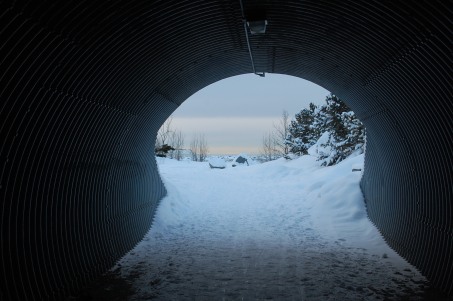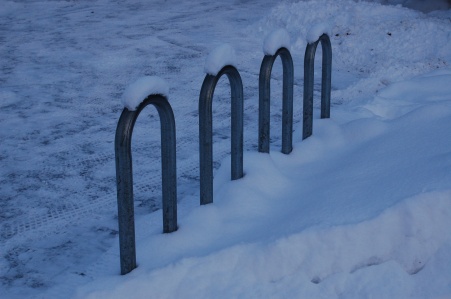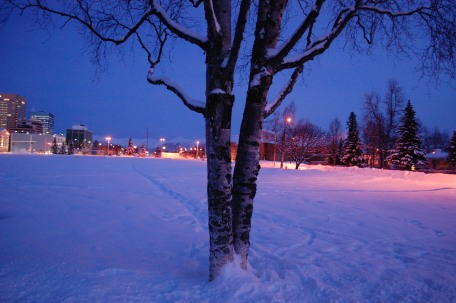You are currently browsing the tag archive for the ‘time’ tag.
The solstice has passed. Daylight is creeping back. The new year is almost here.
2011 has been a pretty good and eventful year, with some big highs (graduating from planning school, moving to Alaska, meeting someone awesome) and a couple lows (mainly, driving my car into a ditch and expensively ruining it).
And reflecting on that (highs and lows) got me thinking about Alaska itself, a place with some pretty serious extremes: extreme light in the summer and darkness in the winter, extreme cold, extreme distance within its borders and from everything else, and a variety of living things (human and otherwise) that adapt to live in these extremes. I’m already adapting some coping strategies – vitamin D supplements and a “happy” light!
Things are pretty good right now, but I feel worn out by the end of this year. Working a lot, eating a lot, missing the sun a lot, woefully behind on things I want to do and keep up with regularly (like this blog). So call it a resolution if you like, I’d like to focus on achieving better balance in 2012.
At work, this means continuing to be mindful of time management among projects, and to make some time to keep up with those things which languish without good maintenance. It also means taking some time off work regularly, planning a few awesome vacations (whether or not I actually leave the city limits).
Along with keeping some boundaries around work and play, I would like to balance my time with more hours for photography, blogging, and general creative activity.
It also means balancing “inside” and “outside” time – taking more walks, in all weather … well, most weather. Maybe learning a new winter activity.
And finally, better balancing my relations with others. Making sure to spend some quality time alone, more quality time with J, to make time for new friends, and of course to make time to keep up with old friends (even if they are far away).
In general, I’d like to be more intentional about my time and how I use it, so I can stop feeling like I’m constantly fighting against the feeling that it slips away. I’d also like to have a better balance in terms of health – eat better, move better, exist better.
I won’t elaborate on the many profound thoughts one can find on the subject of balance, but here’s a nice one:
Order is not pressure which is imposed on society from without, but an equilibrium which is set up from within. ~ Adam Cummings
Happy New Year!
Cities, and people who think about cities, are usually all about place and space. I’d like to make the case instead that cities and the way we think about them – by which I mean, the everyday activities and movement within cities, more than the physical landscape itself – are really all about time.
First, time defines the urban in contrast to the rural. This is not to say that rural areas exist outside of time, but that they experience it differently. Time, in agricultural terms, is cyclical, relying on the predictable recurrence of sunrise and sunset, of spring and summer; action is dictated by the length of day and the growing season. Unpopulated rural areas, forests and wetlands, adhere even more closely to the natural cycle. Extraction operations like mining may rely less on that cycle, but only through the benefit of technologies like electricity and industrial machinery. In popular perception, at least, rural life is slow, unhurried, and “close to nature,” relying on the sun rather than the digital clock to tell the time; urban life, in contrast, is fast-paced, frenetic, and full of impatient crowds, rushing so as not to be late.
Suburbs seem to exist in the middle space between these two ideas – slower and calmer than a bustling downtown, but still tied to time-sensitive activities like the morning commute, the after-school program, and the evening news. Time is still measured, but much of it by the car’s dashboard clock.
It has been observed that we have built our cities with increments of time: the “forty-five minute rule” claims that city size has historically been determined by the length that can reasonably be travelled in forty-five minutes. If on foot, about two to three miles; if in a horse-drawn cart, somewhat longer; if by train or car or motorized bus, longer still. While this may not hold true in all cases, it seems to make sense: a person can only spend so much of their waking hours travelling, or else nothing would get done. City height and density may have been determined in part by construction technology and infrastructure limitations, but its breadth may be most practically determined using travel times, not physical distance.
The importance of time in urban movement – and it seems that urban life is all about moving from one place to another – is most evident in public transit. We often choose one mode over another based on travel times, even if it puts us a couple blocks out of the way; we may even spend more money on a cab just to save time. Using NextBus and similar tracking services, we determine our schedule by the number of minutes to arrival, not the length or even number of stops the bus or train has to travel. Our estimated travel time may make one place seem more accessible than the other, even if they are both exactly one mile away. We measure our reasonable walking radius by minutes as much as by miles; and even in easily-understood grid cities like (midtown) Manhattan or Chicago, we orient ourselves at least as much to the time spent in transit than to the miles we travel every day. In more chaotic cities like Boston or Paris, the zig-zag distances we travel are hard to measure, and it’s not really worth doing so anyway.
A good rule of thumb: most places in Chicago seem to take forty-five minutes to reach; most places in Columbus take ten to twenty. If the destinations are close, we may take a leisurely walk and allow ourselves extra “cushion” time to leave. If they are further away, driving time must include a traffic jam and some time to search for parking; if taking public transit, we build in extra time to wait for the bus or train, and even more if a transfer is required. Unless it’s just up the street, we expect to take some extra time getting there.
Trains are most closely linked to time, and are often disconnected from space. Consider the origin of standard time itself: the development of cross-country train networks in the United States created the need for a common understanding of when noon or eight or five actually occurred, rather than each town measuring for itself by solar position alone. (A plaque near the Chicago Board of Trade building commemorates that city’s part in the “invention” of time.) Because the train’s route and schedule are already circumscribed, we think little of the actual distance we travel, but conceive of the trip more or less as a straight line from A to B, within a given time frame.
Train schedules and maps exist even further out of real, physical space: the stylized, rectilinear diagram of the London or New York subways alter the form of the city itself to be more legible as a network of colorful lines; stations that appear relatively far apart may indeed be only a block or two away, as is the case with the Regent’s Park and Great Portland Street Tube stations in London. [walking] [by train].
Furthermore, particularly for commuter rail with few or no connecting stations, the schedule is all we really need. When will it depart? When will I arrive? The intermediate locations, not to mention the actual path of the track, is irrelevant.
Inter-city travel may be more or less time-dependent than intra-city. While we pay attention to miles on the highway, relying on the odometer and the gas tank to remind us when to stop, when we travel by air, we worry primarily about whether or not we’ll miss our flight. The actual experience of travel is disconnected from the physical distance: we arrive in one airport, wait a bit, board the plane, perhaps watch landing and takeoff and catch glimpses of farm fields before ascending above the clouds, then touch down again at an eerily similar airport elsewhere. Frequent flyer miles remain somewhat arbitrary numbers, points we accumulate over time.
Because movement is such an integral part of urban life, we must inevitably rely on time to determine the rest of our actions. We generally work for a given number of hours, whether or not we are salaried; we take our children to and from school; we must pay attention to opening and closing times of our stores and restaurants and offices; we make appointments and plans and attend events according to the time we have left. And, of course, somewhere in the midst of everything we find time to sleep. We find time, lost time, make time, waste time, need more time or time off. A city itself may be a place, a location, a location in physical space, but in our everyday conception of the city in which we live, it is really a series of time.
I’m leaving the city.
Coming back from downtown tonight, I had a lot to think about (most of which I’m not going to post here). At first I resented all the Lollapalooza goers who had taken over “my” city streets for the weekend – milling around on Michigan Avenue, clustering with cigarettes outside hotels, shuffling along El stations, littering and loitering. I was going to a friend’s place for the day anyway, so I didn’t have time for sight-seeing, but just on principle: couldn’t I spend some last moments in Chicago with the peaceful, generally empty streets at night?
This, however, is not the point. Cities, and particularly Chicago, and particularly its public streets and parks, are for everyone. Just because I am for the moment a city resident, and one who probably walks more than the average resident, my claim to the city as someone who “understands” it isn’t the right attitude to have. Perhaps I’ve appreciated more of the city’s moods than some of those just in for the Lolla weekend, but for this weekend it really is their city as well as mine. It’s easy for locals to grumble about the traffic and bother of special events (I’ve certainly been guilty of this myself), but it is these events, along with the everyday activity, that make the city what it is. It’s okay to avoid the crowds on a summer weekend – but you nevertheless have to appreciate their right to crowd around, and the significance of those crowds for where you live.
And for someone like me, already saying the last parting words to their city, the crowds are a reminder that life goes on. The city continues to move. It is the product of its people, but does not rely on any one person to keep it going (okay, exception in Chicago, Mayor Daley). Maybe I don’t want to remember Michigan Ave with the concert-going throngs; but maybe that’s the best way to remember it. Vibrant, busy, an exciting place to be. How many people have been excited about this event all summer, getting to come to a big city like Chicago? It’s easy to get used to living here, but sometimes it’s easy to forget that it really is a special place.
I also couldn’t help but think about my own mental map of the city – an emotional geography overlaying the grid – and how much I’ll carry with me. The city and I have grown pretty close. A lot has happened here in three years. If and when I come back to visit some of the places on my map, those visits will necessarily be ones of physical place but also temporal place – remembering when I was there and how I felt about it. Some places I’ll be happy to visit. Standing under the Bean at Millennium Park or walking over the river at North Avenue. Other places I’m not so sure. Will it still hurt to walk along Armitage? Can I go back to the Museum of Contemporary Art or look at one of the bridges anytime soon? Probably not. But they’ll be there waiting, either way.
I’ve always been a strongly place-oriented person, even if I didn’t realize it until pretty recently. Planning is therefore a good field for me. History is more about time, which I have much more mixed feelings about, and anyway I think cultural history is more about a particular place (and its people, of course) than it is about the unfolding of time in a chain of causation. Being place-oriented, however, means it hurts like hell to uproot. I know very well that it’s a good time for me to go, not least to clear my head in less memory-saturated air. But it’s not an easy thing.
I’m leaving the city.
But I’m taking a lot of places with me.














